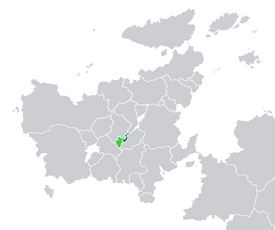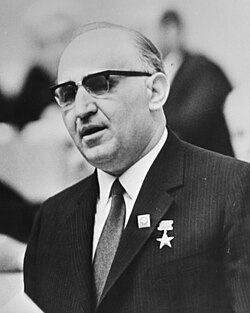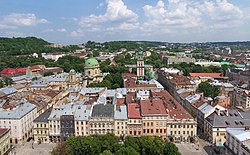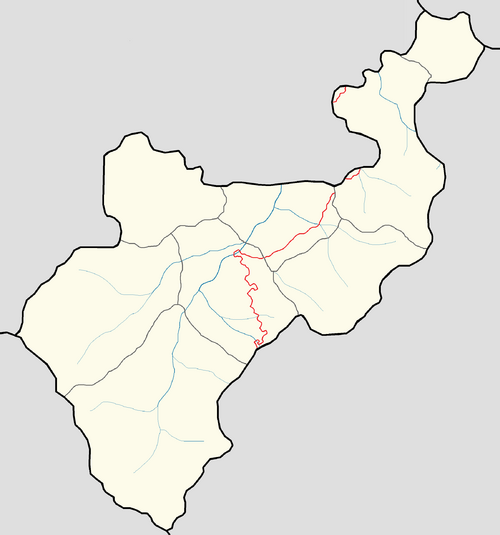Lemovicia
This article is incomplete because it is pending further input from participants, or it is a work-in-progress by one author. Please comment on this article's talk page to share your input, comments and questions. Note: To contribute to this article, you may need to seek help from the author(s) of this page. |
State of Lemovicia Lemovician: Mendiluŕaren heŕialde | |
|---|---|
 | |
| Capital and largest city | Topagunea |
| Official languages | Lemovician |
| Recognised regional languages | Miersan, Savader, Slirnian |
| Ethnic groups (2017) | Miersan (52%) Lemovician (43%) Others (5%) |
| Religion (2017) | Sotirianity (63%) Irreligion (35%) Others (2%) |
| Demonym(s) | Lemovician |
| Government | Parliamentary republic |
| |
| Independence | |
• From Narozalica | 1979 |
| 1992 | |
| Area | |
• Total | 13,547.52 km2 (5,230.73 sq mi) |
| Population | |
• 2017 census | 1,014,866 |
• Density | 74.9115705/km2 (194.0/sq mi) |
| GDP (PPP) | estimate |
• Total | $8,282,321,426 |
• Per capita | $8,161 |
| GDP (nominal) | estimate |
• Total | $2,136,292,930 |
• Per capita | $2,105 |
| Gini (2015) | 25.4 low |
| HDI (2018) | 0.711 high |
| Currency | Lemovician denar East Miersan grosz (MWG) |
| Date format | dd-mm-yyyy |
| Driving side | right |
| Calling code | +98 |
| Internet TLD | .lv.mw |
Lemovicia (Lemovician: Mendiluŕa) is a breakaway state located in central Euclea, bordered to the north and west by West Miersa, and to the south and east by Slirnia, although it claims to border TBD to the west. Situated in the middle of Euclea, it is one of the few doubly landlocked countries in existence in the world. As of 2017, Lemovicia has a population of 1,014,866 people, and with an area of 13,547.52 square kilometres (of a claimed 43,527.68 square kilometres), is one of the smaller countries in Euclea.
(TBC)
Etymology
The area of Lemovicia was the named after the Lemovices, a Tenic tribe who inhabited the present-day region of Lemovicia at the time of the Solarian Empire. The name of the Lemovices derive from the term lemo, meaning elm, and vices, meaning "those who win," which indicates that the Lemovices meant "winners with elm," due to their weaponry being made of elm. However, there are claims that the name may have been what the Tenic inhabitants of present-day Lemovicia referred to the Paleo-Lemovician people, who have inhabited the territory.
The name used by the native Lemovicians to refer to the land is Mendiluŕa, which is a shortened form of Mendien luŕa meaning land of the hills, due to the terrain where the Lemovicians traditionally lived.
Historically, Małomiersa was used to describe Lemovicia, meaning "little Miersa" in Miersan and other Marolevic languages, as it was smaller than Miersa after the Kingdom of Lemovicia was annexed by the Miersans in the (TBD). It is still commonly used in Marolevic countries, and among those who refuse to acknowledge the Lemovician government's sovereignty.
History
Prehistory
Evidence of human habitation of present-day Lemovicia dates back from 16,000 BCE to 12,500 BCE, with stone tools and ruins of paleolithic settlements within the area dating back to around that period of time, particularly in the lowlands of Lemovicia. The highlands of Lemovicia began to be settled from around 9,000 BCE onward, and by around 5,000 BCE, most of Lemovicia had been settled by humans.
However, it is unclear which language or culture they belonged to, although many ethnic Lemovicians claim that they are directly descended from the proto-Eucleans who inhabited Lemovicia.
By the time of the Solarian Empire, Tenic peoples moved into the lowlands, where they were called the Lemovices, while the Lemovicians enter the historical record as the Menes people.
Solarian Empire

Solarians conquer area, settlement generally along flatter areas in the Lowlands, hill regions left alone, but extensive contacts between Lemovicians and Solarians ensue, Sotirianity comes in
Middle Ages
Following the collapse of the Solarian Empire, much of present-day Lemovicia fell under the control of the Empire of Arciluco, as... (TBC)
probable tensions between various states over the land, chieftains switch sides depending on what is more advantageous, then following Arciluco's collapse around 1000, the Kingdom of Lemovicia is founded by TBD
in 1400s or 1500s, ruler of the Miersans is elected by the Lemovicians, personal union with Miersa established
Renaissance
integration with Miersa, union with Kingdom of Lemovicia dies in 1638 when it gets annexed into Narozalica, Lemovicia becomes part of the Narozalic Empire
Industrial Revolution
increased migration from Miersa and Narozalica, increasing Slavicization of Lemovicia, native Lemovician language is threatened by increasing Marolav population, especially in the lowlands
Great War
Due to Lemovicia's geographic location on the border with Amathia and Gaullica, who controlled portions of present-day Slirnia, as soon as Narozalica entered the Great War in 1927, Lemovicia became a strategic target for the Entente forces, as although the southern regions of Lemovicia were mountainous, beyond the Mendija Mountains laid an easy path for the Entente forces to advance into Narozalica.
(TBC)
Post-war

In the aftermath of the Great War, the area of present-day Lemovicia initially remained part of the Miersan Governate. However, as tensions rose across the region, which culminated in the Miersan general strike which also affected Lemovicia, due to its majority Miersan population.
Despite efforts by the Lemovician community to remain part of Narozalica, when the Godfredson Plan was drafted up, as the region of Małomiersa had been "thoroughly integrated" with the Miersan Governate, combined with assurances that Narozalica would continue to have influence over West Miersa, it was decided that Małomiersa was to become part of the newly-established Miersan Federation, as the Małomiersan Voivodeship, with its capital to be in the city of Mistózburó (present-day Topagunea).
Over the following decades, the Lemovician community were subject to a policy of Miersanization, with the Lemovician language being prohibited from being used in schools and in governmental jobs. Thus, while in 1936, the share of ethnic Lemovicians was at 46% of the voivodeship's population, by 1977, it had fallen to a mere 34% of the population, as many Lemovicians either emigrated or assimilated into the dominant Miersan identity.
During this period, coal and iron remained the dominant natural resources of Lemovicia, with these resources being extracted by the government in Żobrodź, but by the 1970s, as coal and iron mines began closing, many ethnic Lemovicians began reasserting their ethnic identity against the Miersan identity, with tensions growing between the two communities. At the same time, two factions sought to assert control of Lemovician nationalism: Eztebe Tolaregain's right-wing Lemovician Cultural Alliance, and the more established Lemovician Section of the Worker's International on the left of the political spectrum.
War of independence

As Narozalica began to collapse on itself with the outbreak of the Second Narozalic Civil War in August 1979, West Miersa found itself without a backer. This gave ample opportunity for East Miersa to launch an invasion of West Miersa in TBD, 1979. With East Miersa invading West Miersa, the Lemovician Section of the Workers' International, led by Ociote Sasiambarena took the opportunity to lead Małomiersa to independence as a "sovereign Lemovician state."
Thus, on 21 November, 1979, in Topagunea, the Lemovician Section of the Worker's International seized control of the government buildings, and proclaimed the independence of the socialist State of Lemovicia, thereby starting the Lemovician War. From the beginning, the fledgling state found itself dependent on East Miersan support to maintain control, given Lemovicia's small population, and the opposition of most ethnic Miersans to the fledgling state of Lemovicia.
(TBC)
Contemporary era

Following the signing of the Alikianos Accords on 22 June, 1992, and the adoption of a new constitution on 1 October of that year, the first free and fair elections were held in Lemovician history the following month, with all seats of the National Assembly, and the Presidency being elected.
Under the term of the first Premier Fabian Duch of the Liberal Democrats, the main priority of the new Lemovician government was to rebuild the country, as the Lemovician Civil War had effectively destroyed the nation's economy: thus, the second denar was introduced in 1993, and he made an attempt to join Samorspi, which was forced to be abandoned following protests by the Lemovician community. By the 1990s, the major cities of Sechia and Loiola have been substantially rebuilt, and with ethnic tensions between the Lemovician and Miersan communities diminishing, the international peacekeeping presence has been reduced significantly, leading to Duch's re-election in 1996, and 2000. By 2004, the first peaceful transition of power in nearly three decades happened, as Otxote Sasiambarrena of the Liberal Democrats became the second Premier.
However, Lemovicia was hit hard with the financial crisis in 2005, and Sasiambarrena's response led to the election of the Socialists under Jan Swiech. Swiech helped to improve the country's economic position, and ensure that the recovery "benefited the people of Lemovicia." By 2011, the economy reached pre-2005 levels, allowing him to get re-elected the following year. However, Swiech's "tax and spend" policies made him unpopular among many, while his plans to join the Euclean Community made him unpopular among many of the Miersans.
Thus, in 2016, Jan Swiech was suceeded by Sergiusz Galecki of the Liberal Democrats as Premier. Under his rule, he abandoned efforts to join the Euclean Community, and instead resumed negotiations to join Samorspi, his economic policies were reoriented which reduced much of the welfare state built up by Swiech. As well, Galecki sought to begin reforms to make the Lemovician government more efficient and accountable, which has been met with substantial controversy, particularly as both the Lemovician Entity and the Miersan Entity fear that they would lose autonomy, while supporters argue that it would help Lemovicia move past the scars of the civil war. In 2020, Lemovicia was officially admitted to Samorspi.
Geography

Lemovicia is traditionally divided into the lowlands (Lemovician: eskariak, Miersan: niziny), situated in the northern regions of the country, and the highlands (Lemovician: mendialdean, Miersan: wyżyny), situated in the southern regions of the country, which is home to the Mendija Mountains, and the country's highest point, at 2,655 metres high, is at Mount Amalur.
The lowlands of Lemovicia have traditionally been more suitable for agriculture, as they are flat and have fertile soil, with the most fertile lands situated along the longest river in Lemovicia, the Andia River. However, the flatness of the lowlands has historically made it vulnerable to foreign invasion, as the lack of geographically defensive features within the region made it an easy target for foreign invasion. In contrast, the highlands are not as suitable for agriculture, but in addition to its defensive capabilities, it is home to much of Lemovicia's natural resources, particularly coal and iron.
Climate
Due to Lemovicia's geographic position in the middle of Euclea, it is on average colder than other places on the same latitude, such as southern Gaullica, northern Bahia, or the west coast of Halland.
The lowlands of Lemovicia have a humid continental climate, with warm summers and cool winters: average temperatures there range from a low of −10.7 °C in January to a high of 25.1 °C in July, with the highest recorded temperature set in Sechia on 13 August, 2019, at 40.3 °C.
In the highlands, although it is closer to the equator, the higher elevations gives it a hot dry-summer continental climate, with average temperatures ranging form a low of −8.0 °C in January to a high of 30.8 °C in July, and the highest elevations give an alpine climate. The lowest recorded temperature in Lemovicia is found in the highlands, with a temperature of -43.9 °C recorded at a weather station near the summit of Mount Alamur on 2 February, 1962.
Economy
For much of Lemovicia's history, the economy of the area was largely based off of agriculture, with fertile valleys along the shores of the rivers, including the longest, the Andia River, helping provide the area with much of their income. While forestry was significant, by the eighteenth century, much of the primeval forests had been cut down.
However, with the discovery of coal and iron, the economy of Lemovicia shifted as these materials were vital for the industrialization of certain countries, especially of Narozalica, which Lemovicia was part of at the time. With this migration, a manufacturing sector emerged, although compared to the rest of Narozalica, this sector was small.
Over the coming decades, its economy became largely based on the extraction of coal and iron, as its manufacturing sector was destroyed by the Great War. While the manufacturing sector was rebuilt in the 1940s, it played a smaller role in the national economy than what it used to.
However, following the start of the Lemovician War in 1979, the Lemovician economy was destroyed, with the result that by 1992, it had one of the smallest economies in the world. (TBC)
Officially, the currency of Lemovicia is the denar (Ð), divided into 100 kobreak, but in practice, the East Miersan grosz is the most commonly used currency in Lemovicia.
Politics
Lemovicia is a federal constitutionally socialist council republic, with the head of state being the Presidency since the adoption of the current Lemovician constitution in 1992, and the head of government being Premier Sergiusz Galecki, who was first elected in 2016, and re-elected in 2020.
The only political party legally allowed is the Lemovician Section of the Workers' International, with the Lemovician Section of the Worker's International controlling 95 of the 110 seats as of 2020, with the remainder of the seats being allocated to independent politicians.
Executive
The official executive of Lemovicia is the presidency (Lemovician: lehendakarica), comprising of four individuals, of which two are from the Lemovician community, one from the Miersan community, and one from other communities in Lemovicia.
The executive is elected from the people, with elections every four years to select the four members of the Presidency. Once elected, the position of Chairman and Vice-Chairman rotate once a year, with the Chairman required to not come from the same group as that of the Vice-Chairman. As of 2020, the current executives are Chairman Alceo Arthobero, Vice-Chairman Damian Rogal, Andremancija Osoteguj, and Surány Tibor.
Legislature
The legislative branch of Lemovicia according to the current Lemovician constitution is the unicameral Lemovician Assembly (Lemovician: Mendiluŕaren bacaŕa), comprising of 110 legislators, elected from the areas under control of the Lemovician government: the areas outside of Lemovician control are unrepresented in the Lemovician government.
The legislature is elected every four years via party-list proportional representation.
Legal system
Traditionally, the legal system of Lemovicia was based off the lehen legeak, which was their own customary law code used by the Lemovicians. However, due to its location within central Euclea, and its history of foreign rule, the Lemovician legal system has been greatly influenced by both the legal systems used in Miersa, and in Narozalica.
Following its independence, Lemovicia adopted a legal system heavily influenced by the socialist legal system used in East Miersa and TBC, with its system of courts being influenced by that of the legal system of East Miersa.
Policing in Lemovicia is provided by the Lemovician Police Force, while defense of Lemovicia is provided by the Lemovician Armed Forces.
Foreign relations
Due to Lemovicia's status as a partially-recognised state, in conjunction with Lemovicia's socialist ideology, Lemovicia has been perceived by many entities, particularly Samorspi, as being an East Miersan puppet state with very little independence.
As of 2020, it is recognized by X countries, of which it has diplomatic relations with Y, mostly among members of the Association for International Socialism, of which it has applied to join, but has yet to be accepted into its ranks, due to a variety of reasons. It is not a member of the Community of Nations, due to the fact that Narozalica supports West Miersa's claim over Lemovicia.
Administrative divisions
Lemovicia was traditionally divided into seven provinces (Lemovician: probincija, pl. probincijak), covering the entire country. The provinces date back to the original Kingdom of Lemovicia, and were reinstated following Lemovicia's independence from West Miersa in 1979.
Since the end of the Lemovician War in 1992, only four provinces are officially under the control of the Lemovician government (in whole or in part), with the remainder being part of the West Miersan voivodeship of Malomiersa. It also controls what it considers the Slirnian Autonomous Region, which according to West Miersa is part of the voivodeship of Nadmorzem.
| Map | Province | Capital | Population (2017) |
|---|---|---|---|
| Bidegurucean | Topagunea | 490,602 | |
| Egunsentian | Bailaŕa | 191,255 | |
| Ibaiak | Goikoecija | 0 | |
| Ilunabaŕa | Zubihaŕa | 0 | |
| Lautada | Ipaŕateja (de-jure) Kocija (de-facto) |
21,957 | |
| Lurbelca | Haizekaŕa | 0 | |
| Slirnian Autonomous Region | Heŕibeŕija | 69,753 | |
| Zelaja | Zubizurija | 301,052 |
Demographics
As of the 2017 census, 1,014,866 people live in the area controlled by the authorities in Lemovicia. (TBC)
Ethnicity
As of the 2017 census, the largest ethnic group, at around 95.5% of the nation's population, or 968,497 people, are the indigenous Lemovicians, spread out across Lemovicia.
Of the remainder of the country's population, 20,297 people, or two percent of the nation's population, are Miersans, while 15,222 people, or around 1.5% of the nation's population, are Savaders, and the remainder belong to other ethnic groups.
Religion
As of the 2017 census, around 63% of the population, or 639,366 people, are adherents to Sotirianity, while around 35% of the population, or 355,203 people, are irreligious, and two percent of the population, or 20,297 people, follow other religions.
The largest sect of Sotirianity practiced in Lemovicia is the Episemialist Church, with 629,217 adherents, making up around 62% of the Lemovician population. While historically, the Miersan Episemialist Church served as the church of present-day Lemovicia, since Lemovicia's independence, the Lemovician government has cracked down on the Miersan Episemialist Church in favor of the Lemovician Episemialist Church, which uses the Amathian rite, but uses Lemovician as a liturgical language instead of Miersan and Old Church Marolevic.
Other prominent sects of Sotirianity practiced in Lemovicia include Catholicism, practiced by 3,383 people, or 0.3% of the population, and Witterism, practiced by 2,167 people, or 0.2% of the population, with a whole slew of other sects making up the remaining Sotirian population, or 4,599 people.
Since independence, the number of irreligious people have grown, in part due to official policies encouraging state atheism. As of the 2017 census, around 35% of the population, or 355,203 people identify themselves as being irreligious, which the census defines as being either agnostic or atheist.
Finally, among the remaining 2% of the population who follow other religions, most of them follow Lemovician neopaganism, with a sizable minority of Marolevic neopagans.
Language
Since Lemovicia's independence in 1979, it has one official language, the Lemovician language. However, it recognises three minority languages under the Constitution of Lemovicia: Miersan, Savader, and Slirnian, and allows government services to be provided in these languages where there is a sizable population of Miersans, Savaders, or Slirnians.
As of 2017, 618,559 people, or around 61% of the population, speak Lemovician as a first language, mostly ethnic Lemovicians and among younger generations. Miersan is the first language of around 37% of the population, or 375,500 people, mostly by ethnic Lemovicians born prior to 1979, or by the Miersan community. Savader is spoken as a first language by 1.2% of the population, or 13,091 people, virtually all among the Savader community. Finally, Slirnian is spoken as a first language by only 793 people, or around 0.08% of the population, mostly by the Slirnian community.
Finally, 6,923 people, or around 0.7% of the population, speak other languages that are not recognised by the Lemovician government, mainly TBD.
Largest cities
Largest cities or towns in Lemovicia
2017 census | |||||||||
|---|---|---|---|---|---|---|---|---|---|
| Rank | Province | Pop. | |||||||
 Topagunea  Zubizurija |
1 | Topagunea | Bidegurucean | 148,572 |  Bailaŕa  Goikoecija Beŕija | ||||
| 2 | Zubizurija | Zelaja | 74,286 | ||||||
| 3 | Bailaŕa | Egunsentian | 49,524 | ||||||
| 4 | Goikoecija Beŕija | Zelaja | 37,143 | ||||||
| 5 | Ecijehaŕa | Bidegurucean | 29,714 | ||||||
| 6 | Gotor | Bidegurucean | 24,762 | ||||||
| 7 | Sardeśkak | Zelaja | 21,225 | ||||||
| 8 | Burdina | Bidegurucean | 18,572 | ||||||
| 9 | Heŕibeŕija | CSZ | 16,508 | ||||||
| 10 | Kocija | Lautada | 14,857 | ||||||
Infrastructure
Education
As per the 1992 Lemovician constitution, education is the responsibility of the two entities.
Education in the Miersan Entity is still based on the Narozalic education system as was structured prior to the outbreak of the Second Narozalic Civil War in 1979, and Lemovicia's independence war, while education in the Lemovician Entity is based off of the eastern Euclean educational model, with the differences being due to the Lemovician Civil War, with the government adopting an eastern model of education, while the separatists maintained the Narozalic model of education.
However, since the 2011-12 academic year, university education has been consistent across all of Lemovicia, with three years for a bachelor's degree, and two additional years to get a master's degree.
Healthcare
The healthcare system of Lemovicia is regulated by the federal government, as per the 1992 Lemovician constitution. Thus, the main ministry responsible for overseeing the Lemovician healthcare system is the federal Ministry of Health, currently held by Aiora Harambure as of 2020. The Ministry of Health is responsible for licensing doctors, nurses, clinics, and regulating the operations of doctors, nurses, clinics, and hospitals.
As of 1993, Lemovicia has a single-payer universal healthcare system, and since the Lemovician Civil War has improved the nation's healthcare system. As of 2017, life expectancy is 77.13 years, with 81.53 years for women, and 72.73 years for men.
Transportation
Transportation in Lemovicia is regulated by the Ministry of Transportation on the federal level, as well as by both the constituent entities and the provinces.
The motorway network in Lemovicia is sparse: as of 2019, the only motorways are the A1, which starts at the southern border with Minilov, and then proceeds to go via Goikoetxea, Topagunea, and Sechia to the northern border with West Miersa. the A2 connecting from the border with Minilov in the west, via Zubiharra, Topagunea, and Bailara, before terminating at the border with Slrinia, and the A3, which starts at the border with West Miersa, goes via Domwiej and Sechia, and continues on to Włocłamyśl, before terminating in Slirnia.
Railways are operated by the Lemovia, which was established in 2017 following the merger of Lemovician National Railways, which operated in the Lemovician Entity, and the North Lemovician Railway Service, which operated in the Miersan Entity. Lemovia is responsible for operating passenger services and maintenance of the railway infrastructure, which all use TBD.
There is only international airport in the controlled territory of Lemovicia: Topagunea International Airport, located just south of Topagunea, and serving as the hub for the state-owned flag carrier Lemavia Airlines.
Culture
Arts
Cuisine
Traditionally, Lemovician cuisine is dictated by Lemovicia's geography, as well as the ethnicities inhabiting the country, with Miersan cuisine being more influential in the northern parts of Lemovicia, and Lemovician cuisine more influential in the south of Lemovicia, due to the fact that Miersans form the majority of the population in the north, and Lemovicians form the majority of the population in the south.
Despite the historically poor relations between the two communities in Lemovicia, common pan-Lemovician foods consumed by both the Lemovician and Miersan communities include śeŕa, gazta gogoŕa, kielbasa, pierogi, ospakizun, and pączek. As well, since the end of the Lemovician Civil War in 1992, and the subsequent opening-up of Lemovicia to the world, globalisation has led to foods such as pizza and hamburgers becoming popular, particularly among the younger generations residing in cities.
Sports
Traditionally, ethnic Lemovicians played traditional Lemovician sports, with the most popular traditional sports that continue to be played by the Lemovician community including Harri-jasotzaileak, sokatira, oilar jokoa, and the country's national sport, pilota.
However, due to rule by foreign powers throughout its history, such as by Miersa and Narozalica, combined with migration by Miersans into Lemovicia during the industrial revolution, sports from these countries, such as basketball, zadany, ice hockey, and football have gained popularity in Lemovicia, and are today widely played among all peoples in the country.
Of these, the most popular sports are pilota and football, although pilota is more popular among ethnic Lemovicians than Miersans, while football is more popular among Miersans than ethnic Lemovicians.
Media
Lemovicia has a relatively free press since the end of the Lemovician War and the promulgation of the 1992 Lemovician constitution.
The Lemovician government operates the Lemovician language Lemovician National Television and Radio, which is the only television and radio network allowed to be based in Lemovicia, although foreign television and radio broadcasts from other socialist nations are allowed to be received.
Newspapers are still popular among Lemovicia, with the newspapers of record, and the most popular newspaper,y being the Lemovician language Aztercaileja, with the most popular newspaper from a foreign language being the Miersan Obserwator z Przejścia.
Holidays
| Date | Estmerish name | Lemovician name | Miersan name | Description |
|---|---|---|---|---|
| 1 January | New Year's Day | Урте беріак Urte berriak |
Nowy Rok | Celebrates the start of the year |
| 6 January | Nativity Eve | Заінца еґуна Zaintza eguna |
Wigilia | Celebrates the birth of Jesus Sotiras |
| 7 January | Nativity Day | Ґабонак Gabonak |
Boże Narodzenie | Celebrates the birth of Jesus Sotiras |
| A Sunday in Spring | Easter Sunday | Пазко Pazko |
Wielkanoc | Celebrates the resurrection of Jesus Sotiras |
| 1 May | Labour Day | Ланґілеен еґуна Langileen eguna |
Święto Pracy | Celebrates the achievements of the workers |
| 40 days after Easter Sunday | Holy Thursday | Остеґун Сантуа Ostegun Santua |
Święty czwartek | Celebrates the ascension of Jesus Sotiras to heaven |
| 50 days after Easter Sunday | Pentecost | Мендекосте Mendekoste |
Zielone Świątki | Commemorates the descent of the Holy Spirit |
| 22 June | Memorial Day | Гілдако еґуна Hildako eguna |
Dzień zabójstwa | Commemorates the end of the Lemovician Civil War and all its victims |
| 15 August | The Dormition | Іокарцеарен lokartzearen |
Zaśnięcie | Commemorates Mary entering Heaven alive at the end of her life |
| 1 October | Constitution Day | Констітузіоарєн еґуна Konstituzioaren eguna |
Dzień Konstytucji | Celebrates the promulgation of the Lemovician constitution |
| 21 November | Saint Michael's Day | Сан Міґел еґуна San Migel eguna |
Dzień Świętego Michała | Feast day of Archangel Michael, patron saint of Lemovicia, and national day |
| 31 December | New Year's Eve | Сілбестер Silbester |
Sylwester | Celebrates the end of the year |







